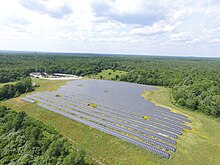Solar landfill
This article has multiple issues. Please help improve it or discuss these issues on the talk page. (Learn how and when to remove these template messages)
|

A solar landfill, also referred to as a brightfield,[1] is a former landfill site that has been transformed into a solar array or solar farm. Landfills that are no longer in use are often called brownfields due to potential environmental concerns. By repurposing these brownfields into solar fields, they become known as brightfields.[2] In the United States, there are more than 10,000 closed or inactive landfills, which have the potential to accommodate over 60 gigawatts of solar installations.[3]
Development[edit]


In 2023 the largest solar landfill completed construction in Houston, Texas. The 50 MW solar array was installed on a 240-acre site that was previously an incinerator and landfill closed by the Environmental Protection Agency (EPA) in 1974.[5]
Landfill sites are often suitable locations for solar farms due to their existing infrastructure, including access roads, electric utilities, and systems for using landfill gas. Additionally, these sites are elevated and devoid of objects that could obstruct solar irradiance.[6] Siting Solar projects on landfills may have the added benefit of not requiring the developer to build on or disrupt existing ecosystems, such as would be the case if the project were to be sited on an area that requires clear-cutting or other modifications.[7][8]
In order to be approved to site a solar project on a brownfield, most states require a measure of rehabilitation to be conducted on the land, including the disposal of on-site hazardous materials[9] as well as ecological restoration such as the introduction of native species, improving the resiliency of the land and ensuring that a stable ecosystem is maintained.[10]
Environmental Impact[edit]
Solar projects sited on brownfields can help mitigate environmental hazards associated with landfill sites by covering and sealing the waste, preventing further contamination of soil and groundwater, and reducing methane emissions through the capture of landfill gas. By repurposing landfills for solar development, previously unusable land can be reclaimed for a productive purpose, reducing the need for new land development and preserving natural habitats.
Prior to development, landfills may require extensive site preparation, including capping, grading, and soil remediation, to ensure the stability and suitability of the land for solar installation. This work has the added benefit of protecting the surrounding ecosystem from the potentially harmful materials within the landfill.
While Solar Farms' impact on wildlife is a hotly debated topic, in many cases, the benefits provided by rehabilitating a landfill in order to site a solar landfill may outweigh the negative effects posed by the existence of a solar farm.[11] Not only does the conversion of landfills into solar farms reduce greenhouse gas emissions and contribute to renewable energy generation, but also repurposes previously unusable land and mitigates environmental hazards associated with abandoned landfill sites.[12]
While capping a landfill serves to mitigate exposure to waste products, there are some potential downsides to this process.
One issue is that capping the landfill may seal off microbiomes in the soil which are often home to diverse species of fungi and bacteria which thrive in the landfill environment, potentially leading to biodiversity loss through partitioning of the two ecosystems. [13]
A potential route to combat biodiversity loss is to utilize the mitigation hierarchy to ensure that proper measures are taken to offset any impacts caused by development.
Challenges[edit]
Regulatory Compliance: Solar development on landfills must adhere to stringent environmental regulations and permitting requirements to address concerns related to soil contamination, habitat disruption, and public health.
Technical Considerations: Solar installations on landfills may face technical challenges related to land subsidence, soil settlement, and ground stability, requiring specialized engineering and construction techniques to ensure the long-term viability of the project.
See also[edit]
References[edit]
- ^ "Solar Brightfields: Gigawatts Of Clean Energy Potential On America's Landfills And Brownfields".
- ^ Barone, Emily (2 June 2022). "U.S. Landfills Are Getting a Second Life as Solar Farms". TIME.
- ^ "The Future of Landfills is Bright".
- ^ https://www.epa.gov/system/files/documents/2023-11/re-on-cl-tracking-matrix-112823.pdf[bare URL PDF]
- ^ "How a Houston Solar Project Empowered a Working-Class Neighborhood".
- ^ "Where Trash Turns into Treasure: The Future of Solar on Landfills". 12 October 2023.
- ^ "Why Aren't More Solar Farms Built on Municipal Landfills?". 2 March 2023.
- ^ Simon, Julia (18 June 2023). "In some fights over solar, it's environmentalist vs. environmentalist". NPR.
- ^ "Brownfield Cleanup Program - NYDEC".
- ^ "Transforming Brownfields for a Greener Future".
- ^ Sinha, Parikhit; Hoffman, Beth; Sakers, John; Althouse, Lynnedee (2018). "Best Practices in Responsible Land Use for Improving Biodiversity at a Utility-Scale Solar Facility". Case Studies in the Environment. 2: 1–12. doi:10.1525/cse.2018.001123.
- ^ Klepeis, Neil E.; Nelson, William C.; Ott, Wayne R.; Robinson, John P.; Tsang, Andy M.; Switzer, Paul; Behar, Joseph V.; Hern, Stephen C.; Engelmann, William H. (2001). "The National Human Activity Pattern Survey (NHAPS): A resource for assessing exposure to environmental pollutants". Journal of Exposure Science & Environmental Epidemiology. 11 (3): 231–252. doi:10.1038/sj.jea.7500165. PMID 11477521. S2CID 22445147.
- ^ Morita AKM; Sakamoto, I. K.; Varesche MBA; Wendland, E. (2023). "Effects of capping on microbial populations and contaminant immobilization in an old unlined landfill". Environmental Science and Pollution Research International. 30 (26): 68548–68562. Bibcode:2023ESPR...3068548M. doi:10.1007/s11356-023-27311-8. PMID 37126164. S2CID 250232441.
Further reading[edit]
- https://www.epa.gov/system/files/documents/2023-11/re-on-cl-tracking-matrix-112823.pdf
- https://www.nyserda.ny.gov/All-Programs/Clean-Energy-Siting-Resources/Transitioning-Underused-Spaces
- https://www.epa.gov/brownfields/supporting-brownfields-redevelopment-using-tax-incentives-and-credits
- https://www.powermag.com/solar-farm-at-a-landfill-site-brings-new-meaning-for-waste-to-energy/
- https://encorerenewableenergy.com/services/brownfields-redevelopment/
- Spiess, Thierry; De Sousa, Christopher (7 August 2016). "Barriers to Renewable Energy Development on Brownfields". Journal of Environmental Policy & Planning. 18 (4): 507–534. Bibcode:2016JEPP...18..507S. doi:10.1080/1523908X.2016.1146986. S2CID 155310511.
- https://www.epa.gov/brownfields/2019-brownfields-federal-programs-guide
